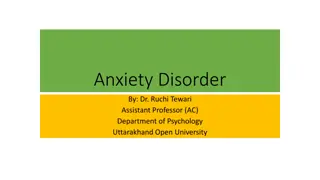Understanding Abnormal Psychology: Disorders, Symptoms, and Treatments
Explore the world of abnormal psychology through the lens of different disorders like depression, anxiety, and phobias. Learn about the definitions of abnormal behavior, DSM-V classifications, and various types of psychological disorders. Delve into the complexities of mental health conditions such as somatoform disorders and dissociative disorders, gaining insight into symptoms and potential treatments.
Download Presentation

Please find below an Image/Link to download the presentation.
The content on the website is provided AS IS for your information and personal use only. It may not be sold, licensed, or shared on other websites without obtaining consent from the author. Download presentation by click this link. If you encounter any issues during the download, it is possible that the publisher has removed the file from their server.
E N D
Presentation Transcript
Ch. 16 18 Ch. 16 Abnormal Psychology
Definition of Abnormality Behavior that is atypical, disturbing, maladaptive, unjustifiable Medical Model: Sicknesses that need to be diagnosed and cured DSM V-R: 5 Levels Level 1 Neurosis & Psychosis Level 2 Personality Disorders Level 3 Physical Problems Level 4 Social Stressors (1-6) Level 5 GAF (1-100)
DSM V-R DSM does not explain the causes of disorders Pro provides a roadmap for treatment Con labels and can create a bias Neurosis: Depression, Anxiety, Somatoforms, Phobias, Dissociatives Psychosis: Delusional Disorder, Schizophrenia Childhood Disorders: Autsim, ADHD, Behavioral Disorders Personality Disorders: Histrionic, Narcissistic, Antisocial, Schizoid, Avoidant, Dependent, OCPD, Borderline
Depression Depression 3 Types -Dysthymia 2 years of lasting mid to moderate depression -Major Depression 2 weeks of severe depression including suicidal thoughts and actions -Bi-polar Disorder (Manic Depression): Alternating highs and lows with extremes on each end
Anxiety Generalized Anxiety Disorder (GAD) Highly stressed and anxious most of the time Panic Disorder At least two panic attacks in a month OCD Obsessive-Compulsive Disorder -obsessions: repeated thoughts; compulsions: repeated actions PTSD Post Traumatic Stress Disorder Experiencing something out of the norm which causes excessive anxiety and flashbacks
Somatoforms Psychological problems which turn physical -Hypochondriasis Exaggerating symptoms -Factitious Disorder Creating something that does not exist but believing it does -Malingering Creating something that does not exist for personal gain and knowing it Conversion Disorder Loss of sense due to stress
Phobias Claustrophobia Enclosed spaces Agoraphobia Crowds and outdoors Hydrophobia Water Acrophobia Heights Phobaphobia - Everything
Dissociative Disorders Amnesia Forgetting one s personal information Fugue Forgetting one s identity and traveling to a new location DID (MPD) Taking on two or more distinct personalities with histories of their own (alter-egos); protects the weaker personality
Childhood Disorders ADHD Children who cannot control their impulses and attention -Hyperactivity: cannot sit still, distracted -Impulsive: making decisions without thinking -Inattentive: cannot pay attention, unfocused ODD Oppositional Defiant Disorder Children who are misbehaved, angry and hostile Conduct Disorder Lack of Conscious, violates the rights of others
Childhood Disorders Contd Autism, Aspergers, PDD: Communication disorders, repetitive behaviors, social deficits; PDD (developmentally behind) Separation Anxiety Inability to be apart from primary caregiver Mental Retardation Low IQ and other deficits
Psychosis Delusional Disorder Schizophrenia
Delusional Disorder Generally functions normal in society with the exception of having delusions Delusions Thoughts that are contrary to reality -Bizzare: cannot be possible -non-bizarre: can be possible but still unlikely
Schizophrenia Split Mind Schizophrenia is characterized by an individual who losses the ability to function in society, has delusions and hallucinations, loose associations, and flat affect. 1. Loss of Functioning (-) 2. Hallucinations (+) 3. Loose Associations (+) 4. Flat Affect (-)
Types of Schizophrenia Paranoid (most common) feel likes others are out to get you Disorganized (most severe) makes no sense and generally off Catatonic shows no emotion and is basically non-responsive Residual someone who is not showing symptoms (usually due to medication)
Percents, Likelihoods, Causes 1% of the population is schizophrenic (1/100) Most likely age to develop schizophrenia is between ages 15 25 Cause is strictly genetic; Generally due to a dopamine overactivity in the brain Highest likelihood is: 1) identical twin 2) both parents 3) fraternal twin 4) one parent 5) sibling 6) general population
Personality Disorders Psychological Disorders characterized by rigid, inflexible and enduring behavior patterns that impair relationships and the self, but can still function well in society. Histrionic Center of attention, Sexually seductive, Exaggerative Narcissistic Egotistical, lacks ability to empathize with others Antisocial Lacks a conscience (often CD s in childhood) Schizoid Unable to connect to others, unmotivated to connect, odd, eccentric and some signs of schizophrenia
Personality Disorders Contd Dependent Can t make decisions, let s others walk on them, co- dependent Avoidant Afraid of criticism, being judged and relating to others, but would like to. Particularly afraid of public presentations OCPD Perfectionistic, orderly to the point of losing enjoyment in the activity Borderline Bipolar, idealize & devalues others, extreme, intense emotion and anger which is inappropriate for the circumstance
Ch. 17 - Therapy Therapy Healing of the soul; A confidential interaction between a trained healer and a sufferer Dual Relationship A therapist who involves him/herself in the life of the client in a personal way, or takes on a client whom they know Eclectic Approach The use of a blend of approaches
Psychoanalysis - Freud Psychoanalysis (Freud) Focus on the subconscious; One of the first famous therapies -Free Association Saying whatever comes to mind -Resistance Individual blocks anxiety by refusing to participate -Interpretation Creating insight into subconsciously blocked material -Transference Experiencing strong positive or negative feelings toward the therapist Counter-transference Therapist experiences strong positive or negative feelings toward the client
Psychodynamic Therapy Modern psychoanalysis Face to face and more modern Includes the past and present Interpersonal Therapy Variation of psychodynamic and short-term (12-16 sessions); Somewhat effective for depression
Humanistic Therapy Rogers and Maslow Focuses on present and future, not past Focuses on taking responsibility rather than uncovering hidden issues Focuses on the conscious mind, not the unconscious mind Focuses on promoting growth, not curing illness AKA Client-Centered Therapy Focuses on client s perceptions and giving them unconditional positive regard
Behavioral Therapy Focuses on eliminating fears and anxieties Counterconditioning Pairs the troubling behavior with something positive Aversive Counterconditioning Pairs the troubling behavior with something negative in order to eliminate it Systematic Desensitization (Wolpe) Form of counterconditioning: Create a list (hierarchy) of anxiety provoking responses and pair with relaxation Virtual Exposure Reality Therapy Experiencing anxiety through simulation Flooding Imagining high anxiety situations Implosion Being placed in high anxiety situations
Cognitive Therapy Cognitive-Behavioral Therapy (CBT): Combines the effort to alter the way people think and the way they behave. (Alter thoughts & actions). Family Therapy: Therapy which views the family as a system & attempts to improve relationships and communication within the family. Group Therapy: Allows others to see that problems are similar
Effectiveness of Psychotherapy Is Psychotherapy effective: 89% of clients view psychotherapy as beneficial. Regression toward the mean: The tendency for unusual events or emotions to return towards their average state.
Types of Therapists Counselors (MFT, Pastoral): Focus on marriage & family relations and can focus on the individual s well-being LCSW (Social Workers): Focus on relationships as well as abuse situations. Psychologists (Ph.D): Similar to counselors, also focus on testing. Psychiatrists: MD s who prescribe medications
Psychopharmacology Psychopharmacology: Study of drug effects on the mind and behavior. -antipsychotics (thorazine, chlorpromazine) used for Schizophrenia create side effects of tremors, twitches and Tardive Dyskinesia (similar to Tourrettes Syndrome); -modern antipsychotics (Risperdal, Zyprexia): less side effects but slightly less effective Antidepressants: (SSRI-Selective Serotonin Reuptake Inhibitors): Zoloft, Paxil, Prozac; -These medications lift people from depression and protect them from falling back into deep depressions because they block the reabsorption and removal of serotonin from the synapses. Mood Stabilizing Medications (Lithium): Medications used for Bi-Polar Disorders
Radical Therapies Electroconvulsive Therapy (ECT): Shock Therapy; Rarely used today. Primarily used in the 60 s, 70 s & 80 s as a treatment for depression. Side Effects: Seizures, Memory loss. Repetitive Transcranial Magnetic Stimulation (rTMS): Sends a magnetic field through the skull to stimulate or dampen activity. Also good for depression & not as many side effects. Lobotomy (Psychosurgery): Surgery that removes or destroys brain tissue. Surgery cuts the nerves to the frontal lobe. Procedure was once used on uncontrollably violent patients.
Ch. 18 Social Psychology Social Psychologists study how we influence and relate to each other. Based on Disposition (personality) & Situation (outside influences)
Attribution Theory Attribution Theory: Explaining one s behavior by disposition (personality) or situation. Fundamental Attribution Error: The tendency to underestimate situation and overestimate disposition Attitudes: Feelings based on our beliefs that predispose our reactions to others
Social Concepts Foot-in-the-door Phenomenon: The tendency for people who agree with a small action to comply with a larger one. Cognitive Dissonance (Festinger): In order to reduce discomfort, we bring our attitudes in line with our actions Conformity: Adjusting our behavior or thinking toward a group standard.
Conformity Conditions that strengthen conformity: -one is made to feel inferior -group has at least 3 people -group is unanimous -one admires the group -one has not made a response yet -one s culture encourages respect for standards
Influence Normative Social Influence: Sensitivity to social norms to gain approval or avoid rejection Informational Social Influence: The willingness to listen to others
Conformity Experiments Conformity Experiment (Solomon Asch) showed people 3 lines and asked which one was same as the original. Most experienced discomfort when five others agreed with the wrong line. Milgram Experiment: 65% of adult male teachers fully obeyed commands to continue despite the learners mention of heart condition and cries of protest. Obeyed most when: -close at hand and legitimate authority -prestigious institute -learner was depersonalized or distanced -no role models for defiance
Social Behaviors Social Facilitation: The phenomenon of stronger performance in the presence of others Social Loafing: The tendency for people in a group to exert less effort when pooling their efforts towards a common goal Deindividuation: The loss of self-awareness and self-restraint occurring in group situations that foster arousal and anonymity
Group Behaviors Group Polarization: The enhancement of a group s prevailing inclinations through discussion. Groupthink: The mode of thinking that occurs when the desire for harmony overrides a realistic alternative or choice Prejudice: Unjustifiable and negative attitude towards a group and its members. Stereotype: A generalized belief about a group of people. Discrimination: Unjustifiable behavior towards a group of people.
Social Behaviors Aggression: The physical, emotional, or verbal behavior intended to hurt another. Frustration-Aggression Principle: Frustration creates anger which in turn creates aggression Conflict: A perceived incompatibility of actions, goals or ideas Social Trap: A situation in which the conflicting parties by pursuit of their own goals end up in a mutually destructive behavior
Attraction Mere Exposure Effect: The phenomenon that repeated exposure to new stimuli increases the chances of liking it. Similarity & Proximity: Two most important determinants in attraction. A 3rd is those who are attracted to us especially when self-esteem is low. Passionate Love: Beginning more intense stages of attraction Companionate Love: Deeper and truer attachment to another. Altruism: The unselfish regard for others.
Bystander Effect Bystander Effect: The tendency for any given bystander to be less likely to give aid if others are present. (Kitty Genovese) AKA Diffusion of Responsibility
Final Social Terms Social Exchange Theory: Our social behavior is an exchange process, the aim of which is to maximize benefits and minimize costs. Social Responsibility Norm: Expectation that people will help, not hurt, those who have helped them. Superordinate Goals: Shared goals that override differences among people and require cooperation. GRIT: Graduated and Reciprocated Initiatives in Tension Reduction A strategy designed to decrease international tensions.























